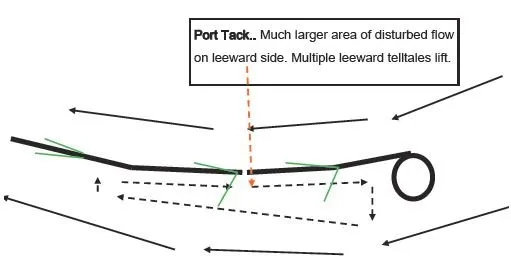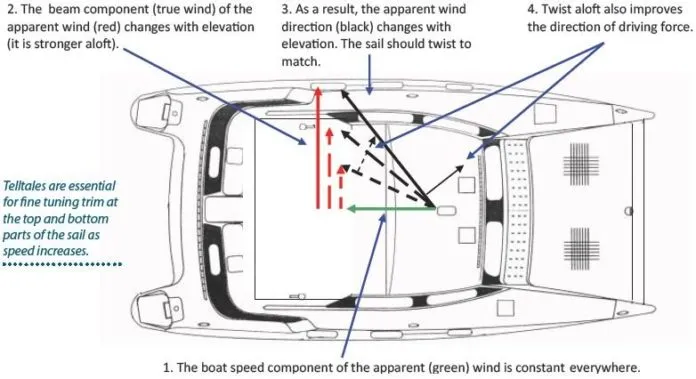Even the most laid-back cruiser has days when he would like to get there an hour sooner. But speed is not the only reason to fine-tune sail trim. Proper sail trim can often eliminate the noise of motoring. Properly trimmed sails last longer.

And finally, when faced with a real blow, being able to trim like a racer, including when reefed, is basic seamanship. The trained ability to wring every ounce of performance from those sails may be all that keeps you off a lee shore or at the proper angle to the waves. Too many close calls saved by the engine can cause a sailor to assume that the auxiliary will always be there to get them out of any pickle. Learning how to drive the boat right at the edge of the performance envelope can help end this over-reliance on the engine.
Genoa. Telltales are placed on both sides of the sail, at a minimum in rows at about, and hoist, the lowest of which must be visible to the helmsman from any position. Avoid seams, since the telltale can hang-up. At a minimum, telltales will be placed 12 inches aft of the luff and way between the leach and luff. If the sail is sometimes roller reefed, a whole row can be appropriate, since the relative locations change when the sail is rolled. A fat foil and a padded luff can also disturb the air flow a little, requiring the first telltale be at least 12-16 inches aft.

Beating. All telltales should flow aft. It is acceptable for the forward telltales on the windward side to occasionally lift and for the forward part of the sail to occasionally shiver, an indication that the apparent wind is as far forward as practical.
Close Reaching. When the apparent wind is forward of the beam, all of the telltales should flow aft, indicating maximum power. Power can be reduced when sailing with wider angles by over-sheeting the sail and stalling the telltales on the lee side (they will droop), but control may suffer, particularly if the main is still properly trimmed. You can also allow excess twist, bleeding power aloft, but the sail will luff if this is taken too far, which is very hard on the cloth and the nerves. Easing the jib sheet only makes the sail too full, increasing power. A better answer is to reduce sail.
Beam and broad-reaching. The aft telltales may stall, particularly down low, because twist is not sufficient. This is normal.
If the sail is roller-reefed, by rolling a portion of the sail around the forestay, the forward most telltale may be influenced by this bulge, particularly when it is on the lee side, trembling occasionally. So long as the next telltale aft is streaming, do not try to trim this out. The sail will also be slightly more efficient to weather when the bulge of the sail is on the windward side, traditionally the starboard tack.
Mainsail
Most cruisers install telltales only on the leach. Body telltales on the windward side will always fly unless the sail is grossly undersheeted, and so are of minimal value. The leading telltale on either side may lift due to mast turbulence, which is even more disruptive that the turbulence in roller furling genoas. Telltales on the leeward side will always stream aft if the genoa is properly trimmed. The wind rushing through the slot keeps them blowing straight back-so they are useless for trimming.
Finally, telltales on the body of the sail are subject to damage by the lazyjacks. And thus, the most important indicator is the leach telltale, which tells us whether air is leaving the leach of the mainsail cleanly, or if the sail is stalled, which will cause the telltales to suck behind the sail. The masthead wind indicator also provides important information at the masthead; the sail should be trimmed just slightly to windward of the vane angle.
Beating. The telltales should stream aft.
Close and broad reaching. The telltales should streamaft.
Running. The sail will stall and the telltales will suck behind the sail. This is normal.
Rotating masts. Because of reduced mast turbulence provided by a rotating wing mast section, body telltales can be useful; however, they should be farther aft, about two feet behind the mast. Follow similar rules as for genoa telltales. Power can be lessened by reducing mast rotation (reduces draft), particularly if the mast incorporates pre-bend.
Fractional rigs and small jibs. Particularly when paired with a wing mast, the mainsail becomes the main driver. Add body telltales and trim the telltales as per the genoa.
Match the twist. Unless the boat is sitting still, the wind at the masthead and the wind at the deck are different. Trimming the sails to match this twist maximizes power and optimizes the orientation of the lift. Telltales will show you the way.
Telltales are sometimes installed on spinnakers as well, though most sailors read airflow on the chute through the motion of the cloth, watching for curling at the leading edge.



































